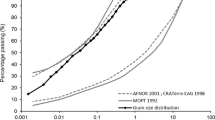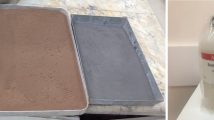Abstract
Increasing use of rock materials like shale in building, roofing, embankment filling, brick manufacturing, and in other civil structure application makes it an important rock to consider in construction engineering. Knowledge of thermal and physical properties of shale as building material is required to predict the rock’s strength and permanence against weathering. Inconsistent heat capacity of anisotropic rock can result in differential heat flow. This tendency can expand the building materials leading to reduction in strength and initiate disintegration. Authors have studied various thermo-physical properties of anisotropic shale from Tennessee, which is commonly used as building stones and bricks. Experiment was designed to measure the basic thermal property, ‘heat capacity’ of shale. Series of laboratory tests including durability, strength, specific gravity, moisture content, and porosity were conducted to determine the physical and mechanical behavior of the samples. Results indicated that properties like porosity, strength and heat capacity varied significantly within samples, where as specific gravity and moisture content yielded steady values. Multivariate regression analysis was performed to evaluate possible correlations among the tested properties. Strong positive relationship was evident between heat capacity, and porosity. Heat capacity and Unconfined Compressive Strength of shale were inversely related. This study emphasized that physical and thermal properties of shale are directly linked with strength and durability of the rock mass.





Similar content being viewed by others
References
ASTM (1996) Annual book of ASTM standards, soil and rock (1): D 420-D4914, Vol 4.08, American Society for Testing Materials publication, West Conshohocken, p 1000
Broch E, Franklin JA (1972) The point load strength test. Int J Rock Mech Miner Sci 9:669–697
Benavente D, Cultrone G, Gómez-Heras M (2008) The combined influence of mineralogical, hygric and thermal properties on the durability of porous building stones. Eur J Miner 20(4):673–685
Benavente D, García del Cura MA, Fort R, Ordóñez S et al (2004) Durability estimation of porous building stones from pore structure and strength. Eng Geol 74(1–2):113–127
Brown ET (1981) Rock characterization, testing and monitoring. Pergamon Press, Oxford
Franklin JA, Chandra A (1972) The slake durability test. Int J Rock Mech Min Sci 9:325–341
Franklin JA, Dusseault MB (1991) Rock engineering applications. McGraw-Hill, New York
Fuenkajorn K (2002) Design guideline for salt solution mining in Thailand. Res Dev J Eng Inst Thailand 13(1):1–8
Graves RM, Batarseh S, Parker R, Gahan G (2002) Temperatures induced by high power lasers: effects on reservoir rock strength and mechanical properties. SPE/ISRM Rock Mechanics Conference, Irving
ISRM (1985) Rock characterization, testing, and monitoring. ISRM suggested methods. Pergamon Press, Oxford
Johnston D (1987) Physical properties of shale at temperature and pressure. Geophysics 52(10):1391–1401. doi:10.1190/1.1442251
Mod’d BK, Howarth RJ, Bland CH (1996) Rapid prediction of building research establishment limestone durability class from porosity and saturation. Q J Eng Geol 29:285–297
Montoto M, Mateos M (2006) Characterization of water pathways in low permeable rocks at the rock matrix scale: methodological review. J Iber Geol 32(2):197–213
Mutluturk M, Altindag R, Turk G (2004) A decay function model for the integrity loss of rock when subjected to recurrent cycles of freezing–thawing and heating–cooling. Int J Rock Mech Miner Sci 41:237–244
Nandi A, Whitelaw M (2009) Effect of physico-chemical factors on the disintegration behavior of calcareous shale. Environ Eng Geosci 15(4):273–285
RP 40 (1998) Recommended practice for core-analysis procedure, 2 edn, American Petroleum Institute, Washington
Rusnak JA (1998) Application of the coal mine roof rating, derived from drill core. In: The roof support design of a coal belt conveyor tunnel. Proceedings of the 17th International Conference on Ground Control in Mining, Morgantown, WV, pp 221–230
Santi P (2006) Field methods for characterizing weak rock for engineering. Environ Eng Geosci 12(1):1–11
Schärli U, Rybach L (2001) Determination of specific heat capacity on rock fragments. Geothermics 30(1):93–110
Scherer GW, Flatt R, Wheeler G (2001) Materials science research for the conservation of sculpture and monuments. MRS Bull 26:44–50
Shakoor A, Brock D (1987) Relationship between fissility composition and engineering properties of selected shales from Northeast Ohio. Environ Eng Geosci 24(3):363
Smith HJ (1997) The point load test for weak rock in dredging applications. Int J Rock Mech Min Sci 34(3–4), Paper No 295
Sonmez H, Osman B (2008) The limitations of point load index for predicting of strength of rock material and a new approach. In: Yazdir S (ed) Proceedings of the 61st Geol. Congress of Turkey. Ankara, Turkey, pp 261–264
Ugur I, Demirdag S (2006) Investigation of the relation between the specific heat capacity and material properties of some natural building and facing stones. Int J Rock Mech Min Sci 43(5):831–835
Vallejo LE, Welsh RA, Lovell CW, Robinson MK (1993) The influence of fabric and composition on the durability of Appalachian Shales Rock for erosion control. American Society for Testing Materials publication; Special Tech Pub 1177, Philadelphia, Pennsylvania
Waikili KG, Binder B, Vonbank R (2003) A simple method to determine the specific heat capacity of thermal insulations used in building construction. Energy Build 35(4):413–415
Author information
Authors and Affiliations
Corresponding author
Rights and permissions
About this article
Cite this article
Nandi, K., Nandi, A. & Litchey, T. Effect of heat capacity and physical behavior on strength and durability of shale, as building material. Mater Struct 45, 1465–1472 (2012). https://doi.org/10.1617/s11527-012-9850-1
Received:
Accepted:
Published:
Issue Date:
DOI: https://doi.org/10.1617/s11527-012-9850-1




